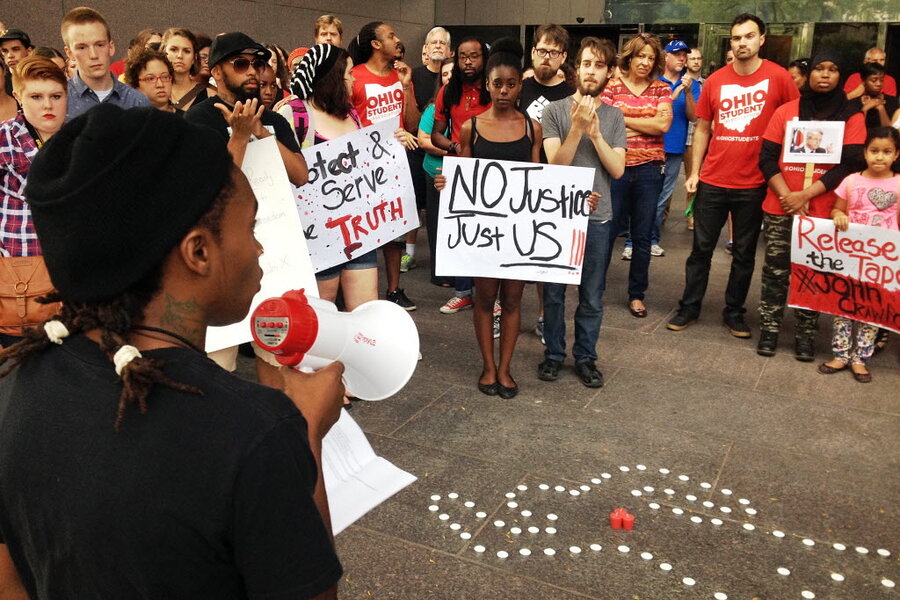In Ferguson's wake, outcries arise about police shootings in other cities
Loading...
Although national attention is fixed on the Missouri protests that have followed the death of Michael Brown 10 days ago, Mr. Brown was not the only apparently unarmed young black man killed by police this month.
And, perhaps influenced by the attention to Brown’s death, smaller protests and demands for answers are beginning to gain steam in other communities.
In Los Angeles, 25-year-old Ezell Ford was shot and killed by police on Aug. 11, just two days after Brown’s death. According to news reports, the unarmed man was mentally ill. Police say that after they approached him he tackled one of two officers and was trying to get the officer's gun, but witnesses dispute that version of events and say there was no struggle between Ford and the officers and that Ford was surrendering. On Sunday, protesters gathered outside the Los Angeles Police Department headquarters to demand more information, and an attorney that Ford’s family has hired has promised a wrongful-death suit.
In Beavercreek, Ohio, meanwhile, John Crawford, a 21-year-old black man, was killed by police inside a local Walmart on Aug. 5 while handling an air rifle that police apparently believed was a real gun. Customers called police to report a man with a rifle in the store, and police say that Crawford refused to drop the air rifle when they asked him. Crawford was on the phone with his girlfriend when the police approached, and she heard him say “It’s not real,” before shots were fired.
Protests have been building in Ohio as well, including some 100 people who gathered at the attorney general’s office in Columbus on Monday night to demand release of the store’s security video.
The factors that cause one incident to get widespread media coverage and national attention and allow a similar one to go under the radar can be idiosyncratic, says Ronald Weitzer, a sociologist at George Washington University who has studied racial profiling and policing. But having a cluster of such fatal incidents could start to have an effect, he says.
“Once a critical mass of these incidents occur in real time it can certainly shift public opinion even among those … who previously might have thought the police could do no wrong,” says Professor Weitzer. “The silver lining is that it does shed media and public attention [on the issue], and might have some delayed effect on reforms that are necessary not just in Ferguson, but in other cities.”
The protests – perhaps due in part to the national focus on the situation in Ferguson – seem to be having some effect already in Ohio and Los Angeles. On Tuesday, the US attorney in Columbus asked the FBI to investigate Crawford’s shooting, and Attorney General Mike DeWine planned a news conference. And the LA Police Department planned a community forum Tuesday night to discuss Ford’s shooting.
"I knew there was going to be tension because it's coming against the backdrop of Ferguson," Earl Ofari Hutchinson, president of the Los Angeles Urban Policy Roundtable, told the Los Angeles Times, acknowledging that the events in Missouri have helped fuel anger over Ford’s death.
The situation in Ferguson, as well as in other communities where an unarmed person of color has been killed in a police confrontation, has brought attention to long-simmering tension between police and minorities.
In announcing his decision to send Attorney General Eric Holder to Missouri this week, President Obama on Monday referred to those underlying issues, saying that "in too many communities around the country, a gulf of mistrust exists between local residents and law enforcement.”
While it is hard to prove racial profiling or racial bias in policing, the perception of such bias is widespread, particularly among blacks and Hispanics, says Weitzer. And people who are young, male, and black (or Latino) are at much higher risk than other individuals of being stopped and interrogated by police, which can then lead to altercations, he adds.
But Weitzer also emphasizes that police departments vary widely in the way they operate, and notes that those with an emphasis on so-called "community policing" are much more likely to foster trust among residents than those, like New York, that aggressively pursue minor offenses in a crusade against "broken windows."
Those sorts of policies, says Weitzer, are more likely to lead to an officer stopping someone for walking in the street, as occurred with Brown, or for selling cigarettes on the street, as happened with Eric Garner in New York last month, another incident that led to a police-caused death and has sparked protests.
“Other communities have more community-oriented policing and wouldn’t be spending this amount of time, if any, doing these sort of low-level stops,” Weitzer says.
On Monday, leaders of 14 civil- and human-rights groups issued a unified call for reforms, including federal reviews of all police killings and excessive use of force, particularly against people of color, as well the universal use of dash cameras in police vehicles – which would record police encounters – and the promotion of community-based policing.






